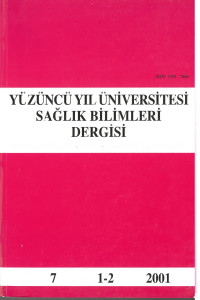Abstract
Bu çalışmada, köpeklerde normal testis ve epididimisler B-mod real time ultrasonografı ile in vivo ve in vitro olarak muayene edildi. Vücut ağırlıkları 14-33 kg arasında, değişik ırktan 11 ergin köpek çalışmada materyal olarak kullanıldı. în vivo muayeneler longitudinal ve transversal planda yapıldıktan sonra, köpeklerden ikisinin testisleri skrotumdan çıkarıldı ve testisler su banyosu içerisinde yeniden muayene edildi. în vivo ultrasonografık muayenelerde, testisler homojen ve orta derecede ekojenik, mediastinum testis, longitudinal planda alman görüntülerde, testisin uzun ekseni boyunca merkezi olarak uzanan hiperekojenik çizgi, transversal planda hiperekojen küçük bir odak şeklinde bütün köpeklerde gözlendi. Kauda epididimis longitudinal plan ve mediolateral yönde yapılan taramalarda sürekli olarak, kaput epididimis ise çoğunlukla görüntülendi. Kauda ve kaput epididimislerin ultrasonografık görünümü homojen yapıda ve testis paranşimine göre ekojenitesi daha azdı. Korpus epididimis, duktus deferens ve pleksus pampiniformisler longitudinal ve transversal planlarda yapılan muayenelerde görüntülenemedi. în vitro muayenelerde mediastinum testisle birlikte testis parenşimi, kaput, korpus ve kauda epididimisler kolaylıkla tespit edildi. Fakat duktus deferens ve pleksus pampiniformisler ayırt edilemedi
Keywords
References
- Pechman CR, Elits BE: B-mode ultrasonography of the bull testide. Theriogenology 27 (2): 431-441, (1987).
- Eilts BE, Wiliamms DB, Moser EB: Ultrasonic measurement of canine testes. Theriogenology 40: 819-828, (1993).
- Pugh CR, Konde LJ, Park RD: Testicular ultrasound in the normal Dog. Veterinary Radiology 31(4): 195-199, (1990). 13. Eilts BE, Pechman RD, Taylor HW, Usenik EA :Ultrasonographic evaluation of induced testicular lesions in male goads. Am J Vet Res 50 (8): 1361-1372,(1989)
- îkinger U, Proussalis A, Bersch W, Möhring K: High- resolution sonography in experimentally induced scrotal pathology. Urol Int 38: 104-108, (1983)
- Karaca F: Koçlarda testis ve epididimislerdeki fizyolojik ve patolojik yapıların ultrasonografı ile belirlenmesi. Doktora Tezi, Konya, (1997).
- Cartee RE., Rumph PE., Abuzaid S, Carson R: Ultrasonographic examination and measurement of ram testicles. Theriogenology 27(2): 431-441, (1990).
- Beck G: Sonographische Untersuchungen an skrotum und Akzessorischen Geschlechtsdrüssen von Wiederkauren, Ebern, Hengsten und Rüden. Vet Med Diss München, (1990).
- Rifkin MD, Kurtz AB, Goldberg BB: Epididymis examined by ultrasound. Radiology 151: 187-190, (1984).
- Willscher Mk, Conway JF, Daly KJ Digiacinto TM, Patten D : Scrotal ultrasonography. The Journal of Urology 130: 931-962, (1983).
- Hericak H, Jeffrey RB: Sonography of acute scrotal abnormalities. Radiology Clinics of Nort Amarica 21(3): 595- 602,(1983).
- Fowler RC, Chennells PM, Ewing R: Scrotal ultrasonography: a clinical evaluation. The British Journal of Radiology 60: 649- 654, (1987).
Abstract
In this study, the normal testes and epididymis in dogs were examined in vivo and in vitro with a B-mode real time ultrasonography. Eleven mixed-breed adult dogs weighting between 14-33 kg were used as material in the study. After longitudinal and transversal scanning were made in vivo, the testicles of the two dogs were removed from scrotum and scanned in water bath again. In the in vivo examinations, the testes were homogeneous and moderately echogenic. The mediastinum of testes was consistently seen as linear hyperechoic structure in the Central long axis of the testes in the images taken longitudinally and as a small spot transversally. The tail of epididymis could consistently be imaged using the medial to lateral longitudinal imaging plane. The head of the epididymis could usually be imaged in the medial to lateral imaging plane. The ultrasonographic appearance of the tail and head of epididymis was homogeneous and less echogenic than testes parenchyma. The body of the epididymis, ductus deferens and pampiniform plexus could not be imaged both longitudinally and transversally. In the in vitro examinations, the testes parenchyma with mediastinum testes and the head, body and tail of the epididymis weı*e easily identified, but the ductus deferens and pampiniform plexus could not be identifıed
Keywords
References
- Pechman CR, Elits BE: B-mode ultrasonography of the bull testide. Theriogenology 27 (2): 431-441, (1987).
- Eilts BE, Wiliamms DB, Moser EB: Ultrasonic measurement of canine testes. Theriogenology 40: 819-828, (1993).
- Pugh CR, Konde LJ, Park RD: Testicular ultrasound in the normal Dog. Veterinary Radiology 31(4): 195-199, (1990). 13. Eilts BE, Pechman RD, Taylor HW, Usenik EA :Ultrasonographic evaluation of induced testicular lesions in male goads. Am J Vet Res 50 (8): 1361-1372,(1989)
- îkinger U, Proussalis A, Bersch W, Möhring K: High- resolution sonography in experimentally induced scrotal pathology. Urol Int 38: 104-108, (1983)
- Karaca F: Koçlarda testis ve epididimislerdeki fizyolojik ve patolojik yapıların ultrasonografı ile belirlenmesi. Doktora Tezi, Konya, (1997).
- Cartee RE., Rumph PE., Abuzaid S, Carson R: Ultrasonographic examination and measurement of ram testicles. Theriogenology 27(2): 431-441, (1990).
- Beck G: Sonographische Untersuchungen an skrotum und Akzessorischen Geschlechtsdrüssen von Wiederkauren, Ebern, Hengsten und Rüden. Vet Med Diss München, (1990).
- Rifkin MD, Kurtz AB, Goldberg BB: Epididymis examined by ultrasound. Radiology 151: 187-190, (1984).
- Willscher Mk, Conway JF, Daly KJ Digiacinto TM, Patten D : Scrotal ultrasonography. The Journal of Urology 130: 931-962, (1983).
- Hericak H, Jeffrey RB: Sonography of acute scrotal abnormalities. Radiology Clinics of Nort Amarica 21(3): 595- 602,(1983).
- Fowler RC, Chennells PM, Ewing R: Scrotal ultrasonography: a clinical evaluation. The British Journal of Radiology 60: 649- 654, (1987).
Details
| Primary Language | Turkish |
|---|---|
| Journal Section | Research Article |
| Authors | |
| Publication Date | June 1, 2001 |
| Published in Issue | Year 2001 Volume: 7 Issue: 1-2 |


